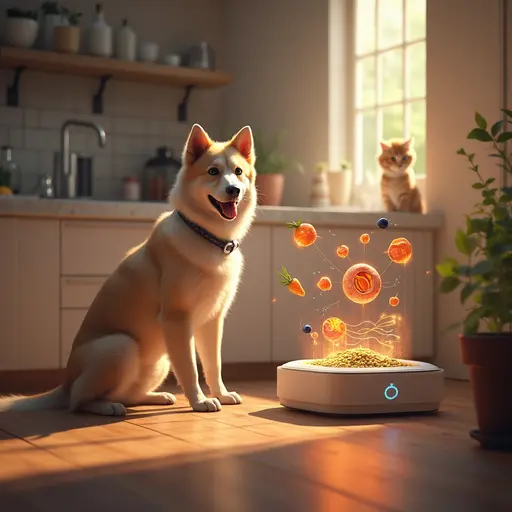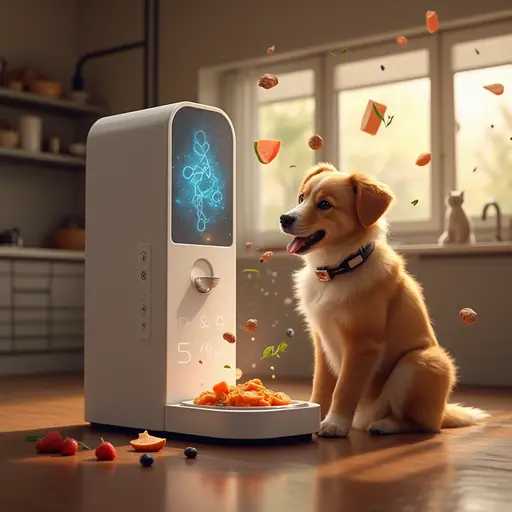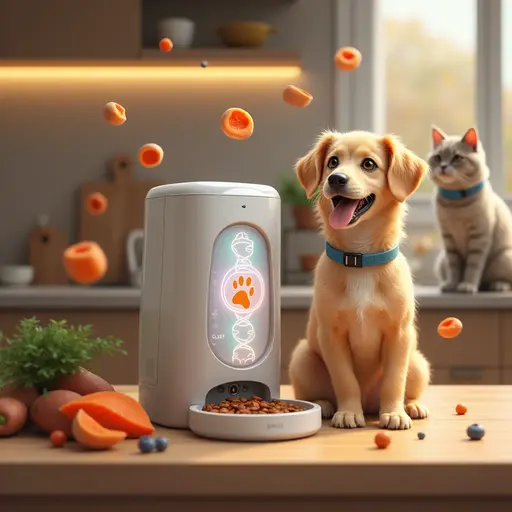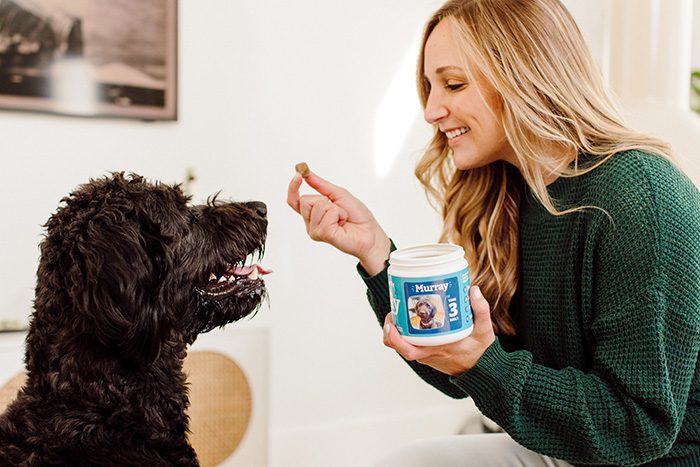Picture this: your cat refuses to eat her new “gourmet” kibble, or your dog’s energy levels dip despite sticking to his usual meals. Pet owners have relied on trial and error—mixed with a dash of guilt—to navigate their furry companions’ diets for decades. But today, a quiet revolution is unfolding in pet care, one powered by algorithms, data, and a surprising ally: artificial intelligence.
Gone are the days of one-size-fits-all feeding guidelines printed on kibble bags. Imagine a world where your pet’s meals are tailored to their unique needs—their breed, age, activity levels, and even subtle health quirks—all analyzed in real-time. This isn’t science fiction; it’s the dawn of intelligent nutrition systems designed to decode your pet’s needs.
Here’s how it works:
- Data-Driven Diets: Sensors and apps track everything from your dog’s morning zoomies to your cat’s hydration habits, feeding insights into AI models.
- Personalized Plans: Algorithms cross-reference your pet’s data with veterinary research, creating meal plans that evolve as they age or their health shifts.
- Preventive Care: Early signs of allergies, weight gain, or nutrient deficiencies? AI flags them before they become problems, suggesting dietary tweaks.
But this isn’t just about high-tech convenience. It’s about bridging the communication gap between pets and humans. After all, our four-legged friends can’t tell us when their joints ache or their stomachs feel off. By translating biological signals into actionable advice, AI acts as a translator—a bridge between species.
From smart feeders that adjust portions based on a dog’s workout to apps that scan pet food labels for hidden allergens, the future of feeding is rooted in precision. And while some may worry about screens replacing snuggles, the truth is simpler: these tools free up time for what matters—playtime, walks, and the joy of a healthy, thriving companion.
Welcome to the next chapter in pet care, where kibble meets quantum computing, and every meal is a step toward a longer, happier life for your furry family member.
How AI is Used in Pet Nutrition

Imagine your golden retriever, Max, bounding through the park one day and limping the next. A decade ago, you might have blamed his limp on aging or a sprain. Today, his smart collar detects subtle changes in his gait, while his feeding app cross-references that data with his recent meals. By breakfast, his bowl automatically adjusts to include joint-supporting nutrients. This is the invisible hand of adaptive meal technology at work—a blend of innovation that’s rewriting the rules of pet health.
At its core, these systems rely on three pillars:
- Behavioral Tracking: Wearables and cameras monitor pets 24/7, logging activity, sleep cycles, and even mood shifts. A lethargic cat might trigger a vitamin boost; a hyperactive puppy could get calorie adjustments.
- Ingredient Analysis: Advanced databases decode pet food labels, flagging irritants like chicken or grains. If your dachshund’s breed is prone to obesity, algorithms prioritize lean proteins and fiber.
- Predictive Health Modeling: By comparing your pet’s data to millions of anonymized profiles, the system spots trends. Maybe your parrot’s feather loss links to a zinc deficiency, or your rabbit’s digestion needs more hay variety.
But how does it learn? Think of it as a digital nutritionist trained on mountains of data—studies on canine cancer, feline diabetes, and even exotic pet longevity. When you input Max’s weight or your parakeet’s feather condition, the model doesn’t just regurgitate generic advice. It layers your pet’s quirks over global research, much like a chef tweaking a recipe for a guest’s allergies.
Take Bella, a diabetic tabby cat. Her owner inputs glucose readings into an app, which then collaborates with her vet’s notes and food database. Over weeks, the system identifies patterns: Bella’s blood sugar spikes with certain fish flavors but stabilizes with poultry. Soon, her meals are auto-adjusted, balancing taste and health without guesswork.
Critics might argue this feels impersonal, but the opposite is true. These tools don’t replace intuition—they enhance it. A Labrador’s sudden disinterest in dinner could mean boredom, dental pain, or a nutrient gap. By ruling out dietary causes first, owners and vets focus on deeper issues faster.
The result? Pets live longer, healthier lives, and owners spend less time worrying about portion sizes or hidden additives. It’s not about robots taking over; it’s about giving every wag, purr, and chirp the best possible chance to thrive.
Welcome to the era where dinner time isn’t just about filling bowls—it’s about nourishing lifetimes.

Benefits of AI in Pet Nutrition
Meet Luna, a spirited beagle who once devoured her meals like a vacuum cleaner—until she started scratching relentlessly. Her owner, Maria, spent months swapping foods, vet visits piling up, and bills mounting. Then came a game-changer: a tailored meal plan crafted by an app that analyzed Luna’s breed, activity, and allergy history. Within weeks, the scratching stopped. Luna’s story isn’t unique—it’s a glimpse into how precision feeding tools are transforming pet wellness, one bowl at a time.
Beyond Guesswork: The Upsides of Intelligent Feeding
1. Healthier Pets, Fewer Vet Trips
- Prevention Over Treatment: By spotting trends like sluggishness or irregular digestion early, these systems suggest dietary tweaks before issues escalate. Think of it as a weather forecast for your pet’s health—dodging storms like obesity or kidney strain.
- Allergy Alchemy: Algorithms cross-reference ingredients with symptom logs. If your hedgehog reacts to mealworms, the system nixes them and suggests cricket protein instead.
- Aging Gracefully: Senior pets get menus rich in glucosamine or antioxidants, slowing age-related decline. A 12-year-old tabby might regain her kitten-like agility with omega-3 adjustments.
2. Effortless Care for Busy Owners
- Auto-Pilot Meal Plans: Forget measuring cups or calorie math. Smart feeders sync with your pet’s data, dispensing kibble tailored to their day—a lazy Sunday vs. a hike-filled Saturday.
- Grocery Hack: Apps generate shopping lists based on your pet’s needs, filtering out unsuitable brands. No more squinting at tiny ingredient lists in the pet store aisle.
- Virtual Vet Support: Some platforms share insights with your vet, turning annual check-ups into collaborative, data-rich conversations.
3. Wallet-Friendly Wins
- Fewer “Oops” Purchases: How much have you spent on food your pet rejected or reacted to? AI narrows options to what works, cutting waste.
- Long-Term Savings: Preventing chronic conditions like diabetes or arthritis means fewer medications, surgeries, or emergency visits. A study by Purdue University found pets on customized diets had 23% lower annual healthcare costs.
- Budget-Smart Customization: Premium plans aren’t the only option. Many tools adjust recommendations to price points, ensuring organic salmon or budget-friendly chicken both meet nutritional goals.
The Ripple Effect: Happier Homes, Thriving Pets
Take Max, a bulldog prone to skin infections. His AI-driven plan eliminated common triggers (like wheat) and added probiotics. Within months, his coat gleamed, and his owner, James, reclaimed weekends previously lost to vet ER trips. “It’s like having a nutritionist in my pocket,” he says.
But the perks go beyond physical health. When pets feel better, they’re more playful, affectionate, and engaged. A study in the Journal of Animal Science linked optimized diets to reduced anxiety in dogs—fewer chewed shoes, more tail wags.
Skeptics might ask: “Isn’t this overcomplicating feeding?” Yet most users report the opposite—simplicity. Instead of drowning in blogs about grain-free trends or raw diets, owners get a clear roadmap.
The Bottom Line
This isn’t about replacing love with algorithms. It’s about empowering pet parents with tools that decode the silent language of barks, meows, and whimpers. Whether it’s a parrot living decades longer or a rescue pup finally thriving, intelligent nutrition isn’t a luxury—it’s the new baseline for responsible pet care.
And as Luna bounds through the dog park, itch-free and energetic, Maria sums it up best: “It’s not just food. It’s peace of mind.”
Real-World Examples
Picture Clara, a Bengal cat with a penchant for knocking over her food bowl—and an even stronger aversion to anything containing fish. Her owner, Sam, spent months cycling through brands, each rejection escalating his frustration. Then he discovered BowlLogic, a startup crafting hypoallergenic recipes using real-time feedback from pets. Clara’s “thumbs-down” swats at her dish were tracked by a smart camera, training the system to avoid fish-derived proteins. Two weeks later, her bowl stayed upright, filled with a duck-and-quinoa blend she devoured.
From Labs to Living Rooms: AI in Action
1. The Brand That Listens to Whiskers
- TailorBites: This subscription service uses a quiz about your pet’s breed, age, and quirks (like “steals broccoli” or “hates crunchy textures”) to create custom kibble. But here’s the twist: their algorithm refines recipes monthly based on fecal sample analysis mailed in by owners. For a terrier with chronic soft stools, the system pinpointed a need for pumpkin fiber and goat milk probiotics—fixing the issue without a single vet visit.
2. The App That Decodes Picky Eaters
- WhiskerWise: A mobile tool that cross-references your pet’s health records with a database of 50,000 pet foods. Snap a photo of a treat’s ingredients, and it flags potential irritants. For Mia, a dachshund with a mystery rash, the app detected a link between her “healthy” sweet potato chews and a tapioca filler. Swapping to a simpler recipe cleared her skin in days.
3. The Feeder That Thinks Ahead
- PetNudge: A smart dispenser that syncs with your dog’s fitness tracker. When Rex’s afternoon walks doubled during a hiking trip, the feeder added 10% more calories—then scaled back as his routine normalized. It even paused portions after detecting uncharacteristic lethargy, prompting his owner to spot an early ear infection.
4. The Vet-Backed Platform Bridging Gaps
- Vetrina: Developed with input from 200+ veterinarians, this system analyzes bloodwork, weight trends, and genetic data (like a golden retriever’s predisposition to hip dysplasia) to suggest supplements. After Max, a senior lab, showed early kidney strain markers, Vetrina recommended a low-phosphorus diet and hydration reminders—extending his active years.
Beyond Gimmicks: Lasting Impact
These aren’t futuristic prototypes. Brands like PurePaw, which uses facial recognition to gauge a cat’s satisfaction mid-meal, are already in homes. Their AI compares “happy chewing” patterns (slow blinks, relaxed ears) to stress signs, adjusting texture and portion sizes. Meanwhile, FarmHound, a farm-to-bowl service, employs satellite weather data to predict ingredient shortages, ensuring your pup’s salmon recipe isn’t derailed by a poor Alaskan fishing season.
Even pet shelters are joining in. The RescueFuel initiative uses AI to design cost-effective, nutrient-dense meals for malnourished rescues. A greyhound named Daisy surrendered with a dull coat and weak muscles and regained her spark on a protein blend optimized for sighthounds—adopted within weeks.
The Takeaway
These stories share a common thread: technology isn’t replacing the bond between pets and owners—it’s deepening it. By turning mealtime into a dialogue, AI helps decode preferences and needs we might otherwise miss. Whether it’s a finicky ferret or an aging Great Dane, the future of feeding is here—and it’s served with a side of bytes.
As Sam laughs watching Clara finally savor her meals, he puts it simply: “It’s like she’s finally got a voice.” And in a way, she does.

AI for Pet Nutrition Challenges and Considerations
Jasper, a mischievous corgi, loved stealing socks—until his AI-powered feeder flagged a sudden drop in appetite. His owner, Lena, panicked, rushing him to the vet only to discover he’d simply grown bored of his salmon kibble. While the system aimed to prevent emergencies, it highlighted a truth: even the smartest tech isn’t flawless. As we embrace intelligent pet care, it’s crucial to acknowledge the bumps in the road—and how to steer around them.
The Fine Print: Balancing Innovation with Caution
1. “Who’s Watching My Pet’s Data?”
- Privacy Puzzles: When a popular diet app suffered a breach in 2023, thousands of pets’ eating habits, GPS locations, and health metrics were exposed. While companies encrypt data, questions linger: Who owns your schnauzer’s health profile? Could insurers use it to hike rates for breeds prone to costly conditions?
- Transparency Gaps: Not all platforms clarify how data trains their models. That “anonymous” info shared with third parties might inadvertently reveal patterns about your household.
2. The Algorithm Isn’t Always Right
- Overreliance Risks: An AI might suggest a low-calorie diet for a plump pug, but miss that her weight gain stems from a thyroid issue—something only bloodwork can catch.
- Bias in the Machine: If training data skews toward certain breeds or regions, recommendations might neglect unique needs. A Shiba Inu’s ideal diet could differ wildly from a Dalmatian’s, but what if the system never analyzed Japanese breeds?
3. Vet vs. Silicon Valley: Who Calls the Shots?
- Complementary, Not Replacement: A startup once marketed an app as a “virtual vet,” leading owners to delay critical care for pets with hidden illnesses. Most experts agree: that AI should inform, not replace, professional diagnostics.
- Regulatory Gray Areas: While the FDA monitors pet food safety, there’s no universal standard for AI-driven nutrition advice. One app’s “perfect meal plan” could be another’s liability.
4. The Cost of Cutting-Edge Care
- Accessibility Walls: Smart feeders and DNA tests can strain budgets. For rescue organizations or low-income families, these tools remain out of reach—widening the gap in pet wellness.
- Subscription Fatigue: “Personalized” often means recurring fees for meal plans or app updates. What happens when budgets tighten, and Fido’s tailored diet gets downgraded to generic kibble?
Bridging the Trust Gap
The solution isn’t abandoning innovation—it’s refining it. Here’s how pioneers are tackling these hurdles:
- Hybrid Models: Apps like PawSync require vet approval for major diet changes, blending AI speed with medical expertise.
- Open-Source Databases: Nonprofits like PetEthics publish anonymized health data for researchers, improving algorithms without compromising privacy.
- Education Initiatives: Workshops teach owners to interpret AI suggestions critically—like questioning a sudden protein reduction for an active working dog.
The Road Ahead
As Dr. Emily Torres, a veterinary nutritionist, puts it: “These tools are like GPS for pet health—they’re brilliant, but you still need to watch the road.” For every misstep, there are triumphs: diabetic cats thriving on AI-adjusted insulin diets, or shelters using predictive analytics to curb malnutrition.
The key lies in mindful adoption—embracing progress while safeguarding the quirks that make pets a family. After all, Jasper’s sock-stealing spree wasn’t in any dataset. But with the right balance of bytes and intuition, even his antics can be part of a happier, healthier life.
Conclusion: A New Dawn for Dinner Time
Picture Milo, a once-picky Persian cat who turned his nose up at every gourmet meal his owner, Clara, offered. Fast-forward six months: Milo now purrs contentedly over a bowl of AI-crafted kibble, blending duck, pumpkin, and a hint of catnip—tailored to his sensitive stomach and finicky taste buds. His story isn’t just about better meals; it’s a window into a world where technology and tenderness coexist, redefining what it means to care for our pets.
The Quiet Revolution on Your Pet’s Plate
Gone are the days of generic feeding charts and guesswork. The rise of intelligent nutrition systems has ushered in an era where:
- Every Bite is a Biography: Meals reflect a pet’s life story—their play habits, health history, and even genetic quirks. A border collie’s diet fuels herding marathons, while a senior guinea pig’s menu soothes aging joints.
- Health Horizons Expand: Proactive care isn’t just for humans. Algorithms now spot subtle red flags, like a parrot’s feather dullness or a rabbit’s irregular chewing, nudging owners toward preventive tweaks.
- Time Becomes a Gift: Automated feeders and smart shopping lists give owners back hours once spent researching brands or measuring portions—hours better spent playing fetch or cuddling on the couch.
Yet this isn’t a tech takeover. The heart of innovation lies in partnership. Veterinarians collaborate with algorithms, merging decades of medical wisdom with real-time data. A golden retriever’s arthritis plan, for instance, might blend AI-driven anti-inflammatory recipes with a vet’s prescribed physiotherapy.
Beyond the Hype: A Balanced Bowl
Critics once feared screens would overshadow scratches behind the ears. Instead, the opposite has unfolded. By streamlining the logistics of care, these tools amplify what matters most: the bond between pets and people. When a diabetic cat’s glucose levels stabilize through AI-monitored meals, her owner isn’t just relieved—she’s free to focus on the joy of shared sunbeams and window-side naps.
Yes, challenges persist—data privacy debates, accessibility gaps, the need for human oversight—but the trajectory is clear. Startups are already addressing these wrinkles, from open-source health databases to sliding-scale pricing models.
The Future in Every Bowl
Imagine a decade from now: A shelter pup’s DNA scan informs a diet that prevents breed-specific ailments, adding years to her life. A rescue parrot thrives on meals adapted to his past malnutrition, his vibrant feathers a testament to precision care. This isn’t a distant dream—it’s the logical next step in a journey already underway.
As Clara watches Milo chase a laser pointer with kitten-like zeal, she realizes the true magic of this shift. “It’s not about gadgets,” she says. “It’s about understanding him—finally.”
In the end, AI-powered nutrition isn’t replacing love; it’s deepening it. By listening to the whispers of whiskers and tail wags, we’re not just feeding pets—we’re nurturing legacies. And in that alchemy of bytes and heartbeats, every meal becomes a promise: to cherish, to protect, and to let every purr, bark, or chirp echo a little longer.









